
 |
| I write regular Strategic Snippets because I care about the success of your business. If you care about the success of someone else's business click "Send this page to a friend". Ask them to let me know that you were involved. |
Contact
Bruce Holland
| mob+6421 620 456 |
| Bruce.Holland@virtual.co.nz |
| Attach:sendpage.gif Δ |
Improve your team's effectiveness by 66.6%
Strategically, the reason why teamwork is so important is because with teamwork your customers get a complete solution, without it they get a piecemeal solution. There is no alternative if you want to deliver an integrated complete solution to your customers, especially today when innovative ideas and fresh thinking are so vital and this can only come from cross-functional teams at every level.
Not finance. Not strategy. Not technology. It is teamwork that remains the ultimate competitive advantage, because it is so powerful and so rare. Especially in a world where Culture assets, Relationship assets, Knowledge assets and Time assets account for 85% of Gross Domestic Product.
How come so many teams - in business - full of talented people, richly resourced, cannot live up to their full potential? Why can't brilliant colleagues get along better? Why won't everyone row the boat in the same direction? If this sounds like your outfit, you might be tempted to chop out a layer of middle management or start laying down the law. Save yourself the pain and read on.
A major opportunity!
Managers assume that because they are frantically busy everyone is, however, the facts show only a few people (only about 5%), are extremely busy. Research shows that 80 percent of workers feel they are not using their strengths on a daily basis. Developing your team can release this energy and productivity!
Teamwork is not easy
For all the attention that it has received over the years from scholars, managers and consultants, teamwork is as elusive as it has ever been within most organisations. It's not easy to pull a group of diverse individuals together to work as a team. Many managers need help because teamwork isn't an intellectual process, it's an emotional process. There are many barriers to overcome. Some of these barriers include over-inflated egos, separation, silos, fierce territoriality, incentive systems that reward individual rather than collective achievement, and mistrust resulting from internal restructuring.
But that is not to say that teamwork is doomed Far from it. In fact, building a team is both possible and remarkably simple. The trick is to think of it as a process and to allow sufficient time for people to be able to change their habits.
We need a process and time to:
- Make sure we have the right people
- Build understanding and communications
- Build trust and
- Change habits and behaviours.
This Strategic Snippet deals with making sure we have the right people. The next three Strategic Snippets will cover the other three parts of the process and will come out weekly so you don't loose track.
1. Make sure we have the right people
Today we have the technology to help us structure teams more effectively. The most effective teams are "whole-brain". There is a great deal of research that shows the importance of balanced teams for effectiveness; I will quote just one. It shows how the productivity of groups can be improved ... dramatically!
The study involved the USDA Forest Service for more than 30 years, over which time they conducted 101 seminars comprising more than 500 teams. Each seminar over this period was rated with an efficiency score designed to measure the productivity of each individual, the potential of the team and the degree to which the team achieved its potential. Up until seminar 93 the Forest Service and their consultants Scientific Methods Inc., experimented by varying the makeup of the teams. Gender, age, ethnicity, salary, education level, type of education degree, job classification and numerous other strategies were used to select members of the team. None of these appeared to affect the productivity of the teams. The average Seminar Efficiency Score was 22.02.
From seminar 94 to 101, a new tactic was used. Team members were profiled using Herrmann's Brain Dominance Index and teams were created by selecting people with heterogeneous thinking styles. The average Seminar Efficiency Score rose to 36.68, an increase of 66.6% on the previous seminars, just because of the way people were selected into teams.
This study and many others show that heterogeneous groups only work better when people understand and value (even cherish) the differences between each other. They need to learn to trust others where they are weak and learn to work together in a synergistic manner. Until teams have achieved this high level of understanding it helps to have one or two balanced thinkers (with equally strong scores in all quadrants) to help those with strong complementary thinking skills understand each other better.
Which team is better?
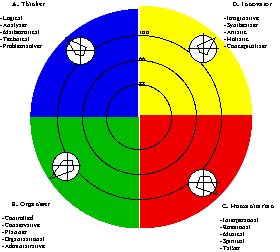
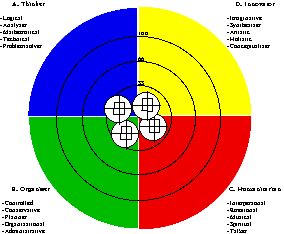
In the left-hand chart we have four people with quite different thinking styles. In the right-hand chart all four have similar thinking styles. Which is better?
Most managers would say the second team is better because they have experienced teams like the first one and found them to be almost impossible to manage. The big As hate the big Cs and visa versa. The big Ds and the big Bs have a similar mutual dislike of each other.
They are just so different from each other they quite literally see different things when they encounter the same situation. What one values the other dismisses as unimportant. How one wants to be appreciated has no value for the other. Where one is strong the other is weak and so on. It's just too hard to make work so they go for the easier way of putting the same peas in a pod.
The good thing about team 2 is they will all get along well together and come easily to rapid decisions. The trouble with team 2 is they are so much alike they don't add much value to each other. If their profiles are square like in team 2 their thinking is average in all quadrants and so the team will be average in all quadrants. If they are all similar but clustered in a single quadrant they will see things from only one point of view and be missing out on different ways of looking at the world.
There is no doubt that team 1 is potentially far stronger if they can work together. To start with the four individuals (each with a score well over 100) are potentially world-class thinkers in their quadrants and therefore the team is also potentially world-class. Each person adds a totally different point of view and sees the world quite differently and this means the team should see the world from all perspectives. The opposites probably don't know it but they need each other to be successful. They need to be trained to understand their differences, value these differences, even cherish them and understand how to work together. In other words they need to understand Herrmann's Brain Dominance Index.
Designing a team
When you know the member's Herrmann scores you can quite literally design teams that work better. The reason a well balanced team is so important is because without it one of these vital functions would be left out:
Know their strengths 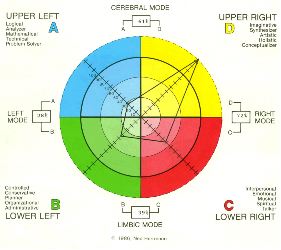
A Types Know the facts
B Types Make it happen
C Types Deal with the feelings
D Types Find a way.
Everyone is different. Some of us are great at precision and detail, others like the person below is great at strategy but hopeless at precision. When you know what someone is great at you can literally redesign jobs so all the work is done by people in their areas of strength.
Any team (no matter what its task is) needs thinking from all quadrants. If you can not find someone to provide strong thinking in a quadrant you should ask someone else to "act in the role". Even a strong A thinker can assume a C thinking style for a short time, they just have to keep reminding themselves about the people issues.
People have different roles in a team because they have different smartness:
Of course sometimes you may want to deliberately unbalance the thinking. For example during brainstorming sessions you may want to weight the team towards D thinkers (or ask the B's to keep quiet).
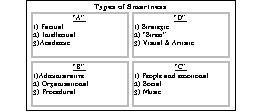
Measure your team
One of the best things about Herrmann is that it shows so clearly whether or not teams are balanced. The diagram below shows how the information about a team is presented. This particular example shows a very strong bias toward "A" and "B" quadrants and would cause me concern if it was a group which had to work together to achieve great ends.
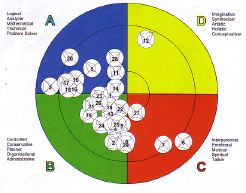
If there is a misbalance in the appropriate centre of gravity Herrmann would argue that it should be corrected (recruitment or training) in order to make the team work most effectively. If people are too similar they will agree too easily, they will not challenge each other sufficiently and they will tend to be "tribal". It's like the old adage that if you have two people who think alike you don't need one of them.
A team which covers all profiles will have the potential to achieve far greater goals but only if they understand and value each other's differences. Herrmann's Brain Dominance Index gives a tool to measure and discuss these differences so that everyone is valued and used where they will be most likely to contribute.
To be continued ...
Bruce Holland
Liberating the human spirit at work
I really believe there is a better way of making work happen - It's mostly about breaking down silos and creating more depth, connection and meaning.


